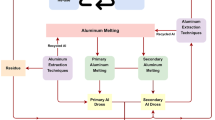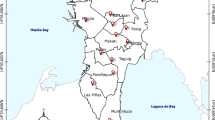Abstract
Dustiness testing using a down-scaled EN15051 rotating drum was used to investigate the effects of storage conditions such as relative humidity and physical loading on the dustiness of five inorganic metal oxide nanostructured powder materials. The tests consisted of measurements of gravimetrical respirable dustiness index and particle size distributions. Water uptake of the powders during 7 days of incubation was investigated as an explanatory factor of the changes. Consequences of these varying storage conditions in exposure modelling were tested using the control banding and risk management tool NanoSafer. Drastic material-specific effects on powder respirable dustiness index were observed with the change in TiO2 from 30 % RH (639 mg/kg) to 50 % RH (1.5 mg/kg). All five tested materials indicate a decreasing dustiness index with relative humidity increasing from 30 to 70 % RH. Test of powder water uptake showed an apparent link with the decreasing dustiness index. Effects of powder compaction appeared more material specific with both increasing and decreasing dustiness indices observed as an effect of compaction. Tests of control banding exposure models using the measured dustiness indices in three different exposure scenarios showed that in two of the tested materials, one 20 % change in RH changed the exposure banding from the lowest level to the highest. The study shows the importance of powder storage conditions prior to tests for classification of material dustiness indices. It also highlights the importance of correct storage information and relative humidity and expansion of the dustiness test conditions specifically, when using dustiness indices as a primary parameter for source strength in exposure assessment.





Similar content being viewed by others
References
Aitken RA, Bassan A, Friedrichs S et al (2011) Specific advice on exposure assessment and hazard/risk characterisation for nanomaterials under REACH (RIP-oN 3)
Barr TL, Seal S (1995) Nature of the use of adventitious carbon as a binding energy standard. J Vac Sci Technol A 13:1239–1246. doi:10.1116/1.579868
Borm PJ, Robbins D, Haubold S et al (2006) The potential risks of nanomaterials: a review carried out for ECETOC. Part Fibre Toxicol 3:11. doi:10.1186/1743-8977-3-11
Brockel U, Wahl M, Kirsch R, Feise HJ (2006) Formation and growth of crystal bridges in bulk solids. Chem Eng Technol 29:691–695
Brouwer D (2010) Exposure to manufactured nanoparticles in different workplaces. Toxicology 269(2):120–127
Brouwer DH (2012) Control banding approaches for nanomaterials. Ann Occup Hyg 56:506–514. doi:10.1093/annhyg/mes039
BS EN:15051 (2006) EN15051 Workplace atmospheres: measurement of the dustiness of bulk materials—requirements and reference test methods
Burdett G, Bard D, Kelly A, Thorpe A (2013) The effect of surface coatings on the dustiness of a calcium carbonate nanopowder. J Nanoparticle Res 15:1311. doi:10.1007/s11051-012-1311-9
Cherrie JW, Gillies AT, Sleeuwenhoek A et al (2009) Modelling exposure to pharmaceutical agents. J Phys Conf Ser 151(1):012063
Engelhard M, Azad S, Peden CHF, Thevuthasan S (2004) X-ray photoelectron spectroscopy studies of oxidized and reduced CeO2(111) surfaces. Surf Sci Spectra 11:73–81. doi:10.1116/11.20050201
Freitag F, Kleinebudde P (2003) How do roll compaction/dry granulation affect the tableting behaviour of inorganic materials? Comparison of four magnesium carbonates. Eur J Pharm Sci 19:281–289
Gbureck U, Dembski S, Thull R, Barralet JE (2005) Factors influencing calcium phosphate cement shelf-life. Biomaterials 26:3691–3697
Haeberle J, Henkel K, Gargouri H et al (2013) Ellipsometry and XPS comparative studies of thermal and plasma enhanced atomic layer deposited Al2O3-films. Beilstein J Nanotechnol 4:732–742. doi:10.3762/bjnano.4.83
Hamelmann F, Schmidt E (2005) Methods for dustiness of industrial powders. China Particuol 03:90–93
Hämeri K, Lähde T, Hussein T et al (2009) Facing the key workplace challenge: assessing and preventing exposure to nanoparticles at source. Inhal Toxicol 21(Suppl 1):17–24. doi:10.3109/08958370903202804
Jensen KA, Koponen IK, Clausen PA, Schneider T (2009) Dustiness behaviour of loose and compacted Bentonite and organoclay powders: what is the difference in exposure risk? J Nanoparticle Res 11:133–146
Kristensen HV, Jensen KA, Koponen IK et al (2010) Nanopartikler i arbejdsmiljøet - Viden og inspiration om håndtering af nanomaterialer. Industriens Branchearbejdsmiljøråd, Branchearbejdsmiljørådet for Undervisning og Forskning samt Universitets og Bygningsstyrelsen, Copenhagen
Kuhlbusch TAJ, Asbach C, Fissan H et al (2011) Nanoparticle exposure at nanotechnology workplaces: a review. Part Fibre Toxicol 8:22. doi:10.1186/1743-8977-8-22
Levin M, Koponen IK, Jensen KA (2014) Exposure assessment of four pharmaceutical powders based on dustiness and evaluation of damaged HEPA filters. J Occup Environ Hyg 11:165–177. doi:10.1080/15459624.2013.848038
Li X, Lenhart JJ, Walker HW (2012) Aggregation kinetics and dissolution of coated silver nanoparticles. Langmuir 28:1095–1104. doi:10.1021/la202328n
Liden G (2006) Dustiness testing of materials handled at workplaces. Ann Occup Hyg 50:437–439
Liguori B, Hansen SF, Baun A, Jensen KA (Submitted) Comparative analysis of occupational exposure estimation tools for nanomaterials and their applicability for reach
Nishii K, Horio M (2007) Chapter 6 Dry granulation. In: Salman AD (ed) Handbook of Powder Technology. Elsevier Science B.V., pp 289–322
Paik SY, Zalk DM, Swuste P (2008) Application of a pilot control banding tool for risk level assessment and control of nanoparticle exposures. Ann Occup Hyg 52:419–428
Pérez-Campaña C, Gómez-Vallejo V, Martin A et al (2012) Tracing nanoparticles in vivo: a new general synthesis of positron emitting metal oxide nanoparticles by proton beam activation. Analyst 137:4902–4906. doi:10.1039/C2AN35863H
Pérez-Campaña C, Gómez-Vallejo V, Puigivila M et al (2013) Biodistribution of different sized nanoparticles assessed by positron emission tomography: a general strategy for direct activation of metal oxide particles. ACS Nano 7:3498–3505. doi:10.1021/nn400450p
Pujara CP (1997) Determination of factors that affect the generation of airborne particles from bulk pharmaceutical powders. Theses Diss Available ProQuest pp 1–155
Rasmussen K, Mech A, Mast J et al (2013) Synthetic amorphous silicon dioxide (NM-200, NM-201, NM-202, NM-203, NM-204): characterisation and physico-chemical properties JRC Repository: NM-series of representative manufactured nanomaterials
Rasmussen K, Mast J, de Temmerman P-J et al (2014) Titanium dioxide, NM-100, NM-101, NM-102, NM-103, NM-104, NM-105: characterisation and physico-chemical properties
Reed RB, Ladner DA, Higgins CP et al (2012) Solubility of nano-zinc oxide in environmentally and biologically important matrices. Environ Toxicol Chem 31:93–99. doi:10.1002/etc.708
Schmidt J, Vogelsberger W (2006) Dissolution kinetics of titanium dioxide nanoparticles: the observation of an unusual kinetic size effect. J Phys Chem B 110:3955–3963. doi:10.1021/jp0553611
Schneider T, Jensen KA (2008) Combined single-drop and rotating drum dustiness test of fine to nanosize powders using a small drum. Ann Occup Hyg 52(1):23–34
Schneider T, Brouwer DH, Koponen IK et al (2011) Conceptual model for assessment of inhalation exposure to manufactured nanoparticles. J Expo Sci Environ Epidemiol 21:450–463
Singh C, Friedrichs S, Levin M et al (2011) NM-series of representative manufactured nanomaterials—zinc oxide NM-110, NM-111, NM-112, NM-113: characterisation and test item preparation
Szepvolgyi J, Mohai I, Gubicza J (2001) Atmospheric ageing of nanosized silicon nitride powders. J Mater Chem 11:859–863
Tardos GI (2005) Wet-granulation research with application to scale-up. China Particuol 3:191–195
Tielemans E, Schneider T, Goede H et al (2008) Conceptual model for assessment of inhalation exposure: defining modifying factors. Ann Occup Hyg 52:577–586
Van Duuren-Stuurman B, Vink SR, Verbist KJM et al (2012) Stoffenmanager nano version 1.0: a web-based tool for risk prioritization of airborne manufactured nano objects. Ann Occup Hyg 56(5):525–541
Witschger O, Jensen KA, Brouwer DH et al (2014) DUSTINANO: a CEN pre-normative research project to harmonize methods for manufactured nanomaterial powders. Aerosol Technology 2014, Karlsruhe. Abstract T230A09. Session APPVI Dustiness and Resuspension: http://www.gaef.de/AT2014/
Xia T, Kovochich M, Liong M et al (2008) Comparison of the mechanism of toxicity of zinc oxide and cerium oxide nanoparticles based on dissolution and oxidative stress properties. ACS Nano 2:2121–2134. doi:10.1021/nn800511k
Acknowledgments
This work was conducted as part of the Strategic Research effort at the National Research Centre for the Working Environment and the Danish Centre for Nanosafety (20110092173/3) from the Danish Working Environment Research Foundation and the EU Framework seven Programme HINAMOX (228825).
Author information
Authors and Affiliations
Corresponding author
Electronic supplementary material
Below is the link to the electronic supplementary material.
Rights and permissions
About this article
Cite this article
Levin, M., Rojas, E., Vanhala, E. et al. Influence of relative humidity and physical load during storage on dustiness of inorganic nanomaterials: implications for testing and risk assessment. J Nanopart Res 17, 337 (2015). https://doi.org/10.1007/s11051-015-3139-6
Received:
Accepted:
Published:
DOI: https://doi.org/10.1007/s11051-015-3139-6




